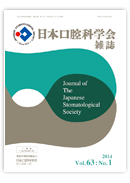All issues

Volume 63, Issue 1
Displaying 1-3 of 3 articles from this issue
- |<
- <
- 1
- >
- >|
ORIGINAL ARTICLE
-
Masaki FUJIMORI, Yoshiyuki TORIYABE, Seiji OHTSUBO, Taiichi NISHIMURA, ...2014 Volume 63 Issue 1 Pages 1-10
Published: 2014
Released on J-STAGE: March 24, 2014
JOURNAL RESTRICTED ACCESSWe devised a treatment protocol for simple tooth extraction that conforms to the “Guidelines for management of anticoagulant and antiplatelet therapy in cardiovascular disease (JCS2004)”. Using this protocol, 1,020 simple dental extractions were performed in patients on antithrombotic therapy (patient group) and in control patients (control group).
We statistically analyzed bleeding after tooth extraction following complete hemostasis (postoperative bleeding), difficulty stopping bleeding after tooth extraction (hemostatic difficulty), background factors, contents of hemostasis, antithrombotic medications, oral surgery specialist qualification of the operator, and PT-INR.In the patient group, 56 cases with hemostatic difficulty were observed (14.7%) and postoperative bleeding (3.1%) after extraction occurred in 12 of the 382 cases. In the control group, there were 12 cases with hemostatic difficulty (1.9%) and one with postoperative bleeding (0.2%) among the 638 undergoing extraction. Hemostatic difficulty and postoperative bleeding requiring serious systemic hemostatic intervention was not observed in any of the cases undergoing extraction. Factors related to hemostasis difficulties were local inflammatory and anti-platelet therapy and warfarin therapy. Factors associated with postoperative bleeding were oral surgery specialist qualification and warfarin therapy.
In this study, tooth extraction was performed employing our protocol which is based on compressive hemostasis. Tooth extraction can be safely carried out during antithrombotic therapy with appropriate local hemostasis. Furthermore, hemostasis was possible with a local hemostatic method in all cases of the patient group and the control group.View full abstractDownload PDF (845K)
CASE REPORT
-
Katsumi IWAYA, Makoto KOGA, Yuko TAKESHITA, Keita TODOROKI, Osamu IWAM ...2014 Volume 63 Issue 1 Pages 11-16
Published: 2014
Released on J-STAGE: March 24, 2014
JOURNAL RESTRICTED ACCESSWe experienced a case of bisphosphonate-related osteonecrosis of the jaw (BRONJ) complicated with myonecrosis of the temporal muscle in a 78-year-old woman, who presented with a swelling in the right temporal region. She had a medical history of polymyalgia rheumatica and osteoporosis, and had been taking prednisolone for polymyalgia rheumatica and bisphosphonate for preventing osteoporosis. A CT scan revealed multiple abscesses in the temporal and masticator spaces. She was admitted to our hospital for anti-inflammation therapy. Even after surgical drainage in the temporal region and oral cavity, necrosis of the temporal muscle spread. Finally, most of the temporal muscle fell out and the temporal bone was exposed. After anti-inflammation therapy and local irrigation, necrotomy and a marginal resection of the mandible against BRONJ was performed under general anesthesia. Now, 29 months after the surgery, exposed bone is observed in the posterior division of the marginal resection of the mandible, so we have been continuing with the follow-up examinations.View full abstractDownload PDF (883K)
ORIGINAL ARTICLE
-
Koji KASHIMA, Koichi TAKAMORI, Hiroshi SAKAI, Yusaku SUEHIRO, Izumi YO ...2014 Volume 63 Issue 1 Pages 17-22
Published: 2014
Released on J-STAGE: March 24, 2014
JOURNAL RESTRICTED ACCESSThis study was conducted to confirm the clinical usefulness of cone-beam CT for dental use (CBCT) in patients with odontogenic maxillary sinusitis and related problems. A total of 124 patients who underwent CBCT examinations between 2010 and 2011 were retrospectively evaluated. Two board- certified oral surgeons examined mucosal abnormalities of the maxillary sinus and other paranasal sinuses, and the distance between the involved tooth root and maxillary sinus using the reconstructed coronal and sagittal images. To survey the relationship between obstruction of the maxillary ostium and sinusitis, thickening of the maxillary sinus membrane was classified coronally into four types according to Kato's classification. As a result, there was a significant correlation between thickening of the membrane and the obstruction of the maxillary ostium. Close proximity between the involved tooth roots and the maxillary sinus floor was highly correlated with this disease, and we confirmed protrusion of the root into the maxillary sinus in many cases of sinusitis. Also, there was significant correlation between obstruction and ethmoidal thickenings. The maxillary first and second molars were more involved than the premolars and third molar, and the root most frequently associated with odontogenic sinusitis was the palatal root of both teeth. Although more research is needed to validate the use of CBCT, our results indicated that it is useful for diagnosing odontogenic sinusitis.View full abstractDownload PDF (542K)
- |<
- <
- 1
- >
- >|